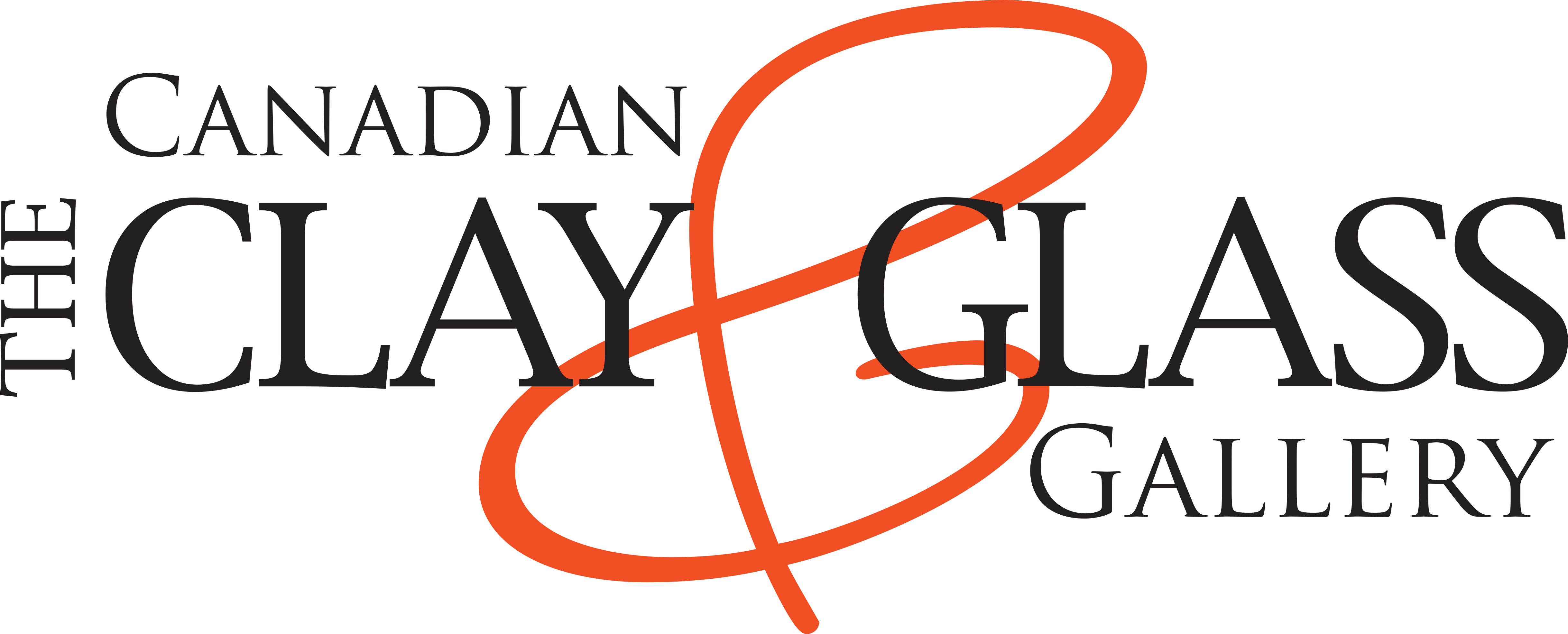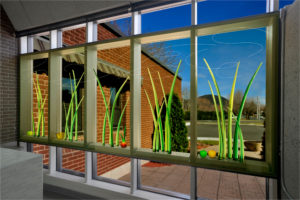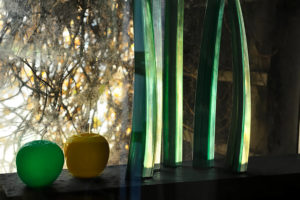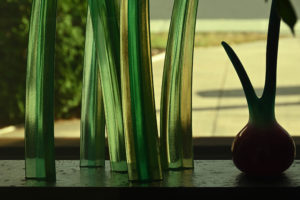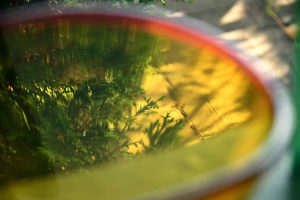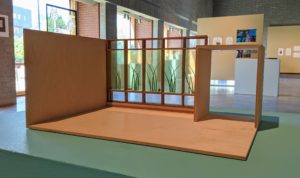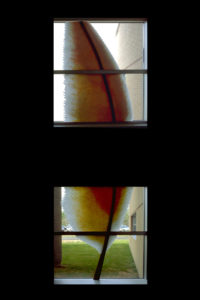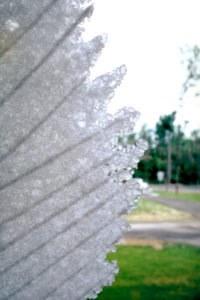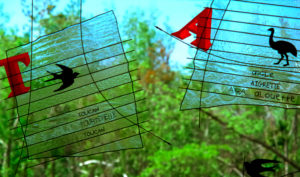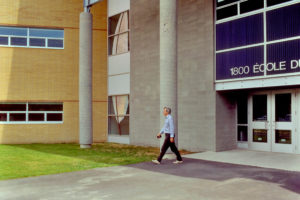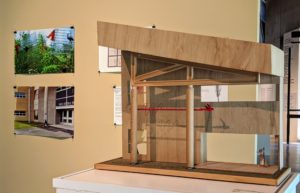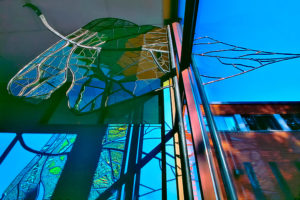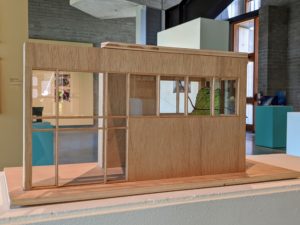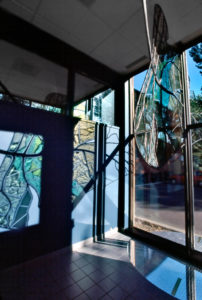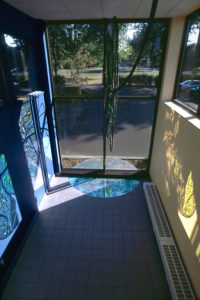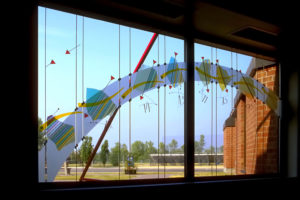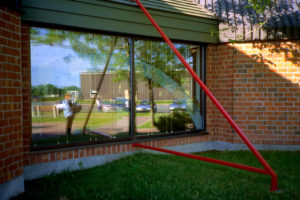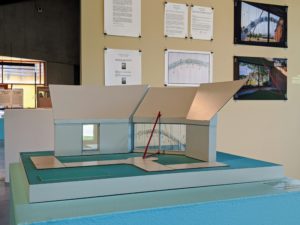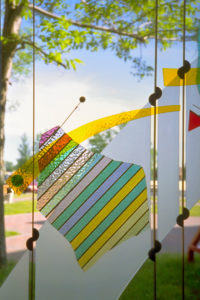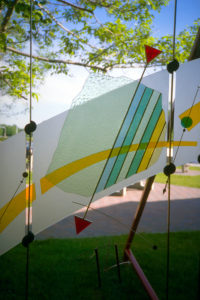English
Michèle Lapointe, glass artist, lives and works in Montreal. Her approach, for both her public art projects and her gallery installations, is articulated around the passing time, memory, and fragility.
In public art, her works are essentially inspired by their location and the people living with and using them. Her creations are as diversified as their locations; the series of work create some king of large green book, an imaginary and gigantic herbarium that testifies of Lapointe’s interest and engagement with nature and its protection.
In her gallery installations, the artist explores more intimate territories, worlds of introspection marked with fleeting memories where true and false are interspersed, where the tangible and intangible are side by side and where the unsaid takes form.
Her creations, where the glass is omnipresent, are found in many collections including the Musée national des beaux-arts du Québec, the Montreal Museum of Fine Arts, the Musée des maîtres et artisans du Québec, the Musée de la civilisation du Québec and the MusVerre of Sars-Poteries, France. Since 1989, she teaches at Espace VERRE and was its Chair from 1995 to 2002.
Avec la collaboration de René Rioux.
With the collaboration of René Rioux.
Texts provided by the artist.
Les oignons rouges, CHLSD Marguerite-Adam, Beloeil, QC, 2011.
L’oeuvre proposée est une verrière tridimensionnelle inspirée de la végétation du lieu et de sa richesse culturelle; elle voisine l’entrée principale de la résidence et crée un lien entre le hall d’entrée et la terrasse extérieure.
Cette œuvre s’inscrit dans ce que j’appelle mon herbier imaginaire ¹ ; il est le fruit d’une réflexion que je poursuis depuis plusieurs années sur l’importance de l’enracinement de tout individu dans son environnement géophysique et sur son besoin vital de se rapprocher de la nature.
La verrière consiste en un tableau horizontal rappelant la chaude couleur du soleil levant où la nature, sous la forme stylisée d’herbes géantes, vertes et transparentes, captent la lumière naturelle. Ces herbes, grossies et simplifiées, sont inspirées des prés verts de la région, captées l’instant d’une photographie lors d’une promenade. Elles prennent racine sur un des meneaux horizontaux de la fenêtre existante.
Dispersés discrètement dans la verrière, cinq éléments de verre coloré ³ – pomme jaune, pomme verte, oignon rouge ou jaune et leur bol – empruntés à l’œuvre picturale d’Ozias Leduc ², évoquent ce qui nourrit le corps et l’esprit tout en faisant référence à la pomiculture et à la culture maraîchère de la région.
Le verre teinté jaune qui enveloppe l’œuvre d’art est gravé de fines lignes; elles animent l’œuvre en symbolisant le vol des insectes au dessus d’un pré, telles des traces virtuelles laissées lors d’un passage fécond.
Par son orientation sud-est, le tableau de verre projettera dans le hall d’entrée ses jeux d’ombres et de lumière jaune et ensoleillée d’un jour levant, rappelant à l’année longue la chaleur des beaux jours d’été.
The proposed work is a three-dimensional glass wall canopy inspired by the surrounding vegetation and its cultural wealth; it is near the principal entrance of the residence and creates a link between the lobby and the exterior terrace.
This work is part of what I called my imaginary herbarium; it is the result of a reflection that I have been pursuing for many years on the importance for an individual to take root in their geophysical environment and on the vital need to get closer to nature.
The large series of windows creates an horizontal tableau recalling the hot colour of the rising sun where nature, under the form of stylized giant grasses, green and transparent, that capture the natural light. These grasses, enlarged and simplified, are inspired by the green meadows of the region, capture in a photography on a walk. They are taking roots on the horizontal mullions of the existing window.
Dispersed quietly on the wall canopy, five elements of coloured glass—yellow apple, green apple, red or yellow onion and their bowls—borrowed from the pictorial oeuvre of Ozias Leduc evoke what feeds the body and the spirit while referencing the apple orchards and vegetable crops of the region.
The tinted yellow glass that wraps the work is engraved of small lines; they animate the work while symbolizing the flight of insects above the meadows, like virtual traces left on a fruitful passage.
By its south-east orientation, the glass œuvre will project in the lobby its plays on yellow light and shadows, on a sunny day rising, recalling all year around the warmth of nice sunny days.
L’insoutenable légèreté de la plume, Kindergarten School, Le Parchemin, Carignan, QC, 1998.
L’oiseau s’est envolé…en vers libres et sans rime
Dans cette cage de papier aux barreaux d’encre bleue.
L’oiseau du paradis, messager des dieux
Arrache de son aile une plume chatoyante.
Après l’avoir bien taillée, il lui révèle l’art de l’écriture
Et libre et sauvage, nous l’avons prise et enfermée
Le pouvoir des mots, clef magique de sa liberté regagnée
En conclusion et en exergue, heureusement que…
Les oiseaux gardent parmi nous quelque chose du chant de la Création.
-Saint-John Perse
The bird has flew…in free verses and without rhyme
In the paper cage with blue inked bars.
The bird of paradise, messenger of the gods
Tears from its wing, a shimmering feather.
After carefully trimming it, it reveals the art of writing
And free and wild, we took and locked it up
The power of the words, magical key of its regained freedom
In conclusion, and highlighting, fortunately…
The birds keep among us something of the Creation song.
-Saint-John Perse
Dans ce projet pour l’école maternelle et primaire le Parchemin de Carignan en Montérégie je suis frappée par la proximité d’un petit boisé où les oiseaux gazouillent en toute liberté. Et de songer à tous ces petits “flos” qui se sentiraient comme des oiseaux en cage…
De là la plume et les oiseaux…
Sur la gauche, dans les fenêtres des 2 étages, une plume immense en pâte de verre: c’est la plume instrument d’écriture, instrument de liberté…La plume des géantes conquêtes qui écrit le titre de l’œuvre: L’insoutenable légèreté de la plume.
Sur la droite, une grande fenêtre: dehors le boisé où volent les oiseaux, dedans les enfants de la maternelle qui rêvent déjà de liberté. Entre les deux, bâtis dans le verre fragile, les barreaux d’une volière en forme de portées musicales… mais dont les notes sont des lettres. Abécédaire à conquérir pour prendre son envol.
Au centre, entre les deux colonnes, un oiseau de métal rouge feu vole vers la liberté.
In this project for the kindergarten school Le Parchemin, Carignan, Quebec, I am struck by the proximity of a small forest where birds sing freely. And to think at all these youngsters who would feel like birds in a cage….
Thus de feather and the birds…
On the left, in the windows of both levels, a large feather in pâte de verre; it is the writing tool, the instrument of freedom…The feather of giant conquests that write the title of the work: The Unbearable Lightness of the Feather,
On the right, a large window; outside a small forest where birds fly, inside kindergarten children already dreaming of freedom. Between both, constructed in the fragile glass, the bars of an aviary in the shape of musical staves…. but the musical notes are letters. The ABC to conquer to take one’s flight. In the centre, between two columns, a fiery red bird fly towards freedom.
La feuille, CLSC, Poine-aux-Trembles, QC, 1999.
Le désir des êtres humains de se rapprocher de la nature s’exprime ici, dans le hall d’entrée principal, par une feuille d’arbre ramassée sur le terrain du CLSC à l’automne 1998.
L’articulation même des nouveaux bâtiments du CLSC démontre ce désir de rapprochement avec la nature. Le bloc arrière, par son positionnement en diagonale et par ses ouvertures laissent pénétrer le fleuve à l’intérieur de la salle d’attente et le hall d’entrée, par l’ampleur de sa fenêtre côté sud offre une ouverture à la végétation.
Dans cette fenêtre, coté sud, disparaît presque complètement la notion intérieur-extérieur par la présence de cette feuille qui traverse cette frontière. La partie “sud” de la feuille située à l’extérieur, par sa forme, symbolise la nature et les hommes soumis aux intempéries du temps et de la vie. La partie “nord” de la feuille qui flotte dans l’espace du hall d’entrée, laisse voir une végétation aux couleurs du printemps, signe de la renaissance. Cette restauration de la vie rappelle la fonction du lieu.
Le mouvement de la feuille est placé dans l’axe nord-sud telle la barre d’un navire symbole de responsabilité et de prudence. Cet axe nord-sud inscrit au sol souligne l’importance pour tout être humain de se sentir situé dans son environnement tant familial que social.
The human desire to get closer to nature is expressed here in the main lobby by a leaf picked up on the property of the CLSC in the Fall of 1998.
The very articulation of the new buildings of the CLSC demonstrate this desire. The rear block, by its diagonal position and its many openings do leave the river to come inside the hall and the waiting room, the size of the window on the south side offers an opening to the vegetation.
In that window, south side, almost disappears the notion of inside-outside by the presence of that leaf that cross that boundary. The south side of the leaf is located outside, by its shape, symbolized nature and humans submitted to the bad weather of time and life. The north side of the leaf floats in the lobby space, let’s see a vegetation in spring colours, sign of rebirth. A restoration of life that recalls the function of the place.
The movement of the leaf is placed in the north-south axis like the helm of a ship, symbol of prudence and responsibility. This north-south axis inscribed on the floor and ground highlights the importance for all human beings to feel attached to their environment, both family and social.
Et pourtant, elle tourne, Municipal Library, l’ile Bizard, QC, 1995.
La grande fenêtre orientée plein midi donne envie de la franchir pour aller vers le soleil…ou alors…d’utiliser la lumière solaire pour marquer le midi. Ainsi naquit l’idée du cadran solaire.
Cette idée paraissait d’autant plus intéressante que, dans un cadran solaire, l’angle du style égale la latitude du lieu, soit 45° 29′ à l’Ile-Bizard et que cet angle est justement celui de la pente du toit de la bibliothèque. Cette concordance des angles mena tout naturellement à placer le style dans le prolongement du toit, en une sorte d’ancrage de l’édifice au centre même du cadran solaire. Passant au travers du toit et dans la structure de l’édifice, le cadran solaire franchit le mur de verre et passe de l’extérieur vers l’intérieur. L’heure se lit donc normalement de l’intérieur et se trouve être ainsi l’heure solaire vraie de la bibliothèque.
Suite au 350e anniversaire de la mort de Galilée en 1642, la murale s’inspire de quelques notions d’histoire de la cosmologie. La citation de Galilée qui donne son titre à l’oeuvre nous rappelle que, malgré les apparences, c’est bien la terre qui tourne et se déplace autour du soleil. Tout comme le soleil est un pivot où se rattache la terre, le cadran solaire devient un centre où se rattache la biblothèque.
On y trouve des formes géométriques simples rappelant les théories cosmiques pré-coperniciennes. Et, à la mémoire de Galilée, la distribution des éléments de la murale ne se fait pas selon un arc de cercle, mais selon la trajectoire elliptique du mouvement de la terre.
On peut y voir des comètes, des planètes, des nébuleuses, des franges d’interférences, des mésons, des quarks et … la lumière … qui, d’un point de vue Einsteinien, relativise le temps à l’espace en nous présentant l’heure (le temps) dans la contraction symbolique de l’espace extérieur vers l’intérieur de la bibliothèque.
The large window fully oriented on noon invites us to cross over towards the sun…to use the sun light to mark noon time. And the sundial idea was born.
The idea seemed all the more interesting that, in a sundial, the angle of the style is the same as the latitude of the place in Ile Bizard, 45° 29′ , which is also the same as the library roof angle. This concordance of angles brought the position of the style to naturally follow the roof pitch, in a kind of anchoring of the building right in the sundial centre. Passing through the roof and within the structure of the building, the sundial crosses the glass wall and move from outside to inside. The time thus should be read from the inside and is the true time of the library.
Following the 350th anniversary of Galileo’s death in 1642, the mural work is inspired by some historical ideas of cosmology. Galileo’s quote that gives the title to the work, remind us that, albeit the appearances, it is the earth who turns and moves around the sun. Like the sun is the pivot where the earth is linked to, the sundial becomes the centre where the library is attached.
There are some simple geometrical shapes reminiscent of pre-Copernican cosmic theories. And, to Galileo’s memory, the distribution of elements do not follow a circle arc, but the elliptical trajectory of the earth movement.
We can see comets, planets, nebulae, interference fringes, mesons, quarks and …the light …that, from an Einstein point-of-view, relativizes time to space by presenting us time in the symbolic contraction of the exterior space towards the interior of the library.
